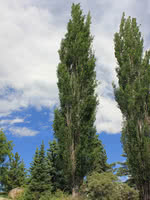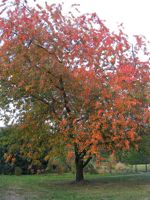Mon-Fri 9am - 5pm Mountain time
Swedish Aspen vs Black Cherry
Populus tremula Erecta
Prunus serotina
NOT AVAILABLE THIS SEASON - MIGHT RETURN
Swedish Aspen is an extremely fast growing columnar aspen tree. It's ideally suited for urban settings where space is limited such as privacy screens or along the edges of driveways. Swedish aspen produces no fluff and is less prone to suckering than tower poplar. Swedish aspen thrives in a variety of growing conditions with little maintenance or pruning.
We grow this species over a two year production method from root cuttings via the Smoky Lake Styro-Stack method (SSS method) first pioneered at Smoky Lake Forest Nursery in 2002. This method has quickly become the gold standard in the reforestation nursery industry for growing clonal aspen.
We are well known for pioneering its use worldwide and currently produce some of the highest volumes of Swedish Aspen in Canada.
Black Cherry is common in eastern North America but a rare find elsewhere. This tree is shade tolerant and is often found in old fields, forest openings, and along fencerows.
The fruit is edible and is commonly used to flavor rum and brandy. It is also edible and often eaten fresh or used in wine or jelly. Black Cherry trees typically begin producing fruit when they are 10 years of age.
Black Cherry wood is a rich reddish-brown color and is strong, making it valued in cabinetry and woodworking. It is often used in reclamation as well.
The leaves can poison livestock as they contain cyanide derivatives and precursors. However, many have noted that deer still seem to browse their trees with impunity and birds and other animals eat the fruit when available.
Swedish Aspen Quick Facts
Black Cherry Quick Facts
Toxicity: bark and wilted leaves toxic to livestock

